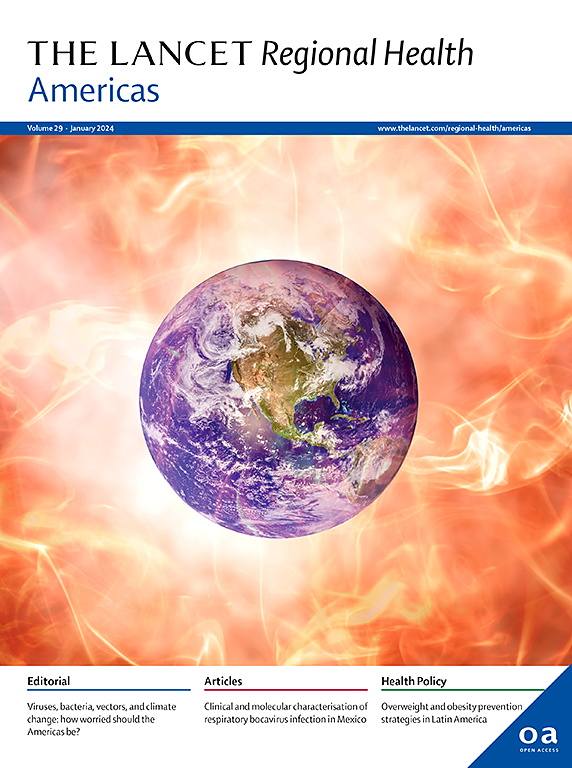Population attributable fractions of modifiable dementia risk factors for cognitive impairment—the ELSA-Brasil cohort study
IF 7
Q1 HEALTH CARE SCIENCES & SERVICES
引用次数: 0
Abstract
Background
Population attributable fractions (PAF) of modifiable dementia risk factors are rarely estimated in low- and middle-income countries. We aim to estimate the relative risk (RR) for cognitive impairment and calculate the PAF in the Estudo Longitudinal da Saúde do Adulto (ELSA-Brasil).
Methods
We analyzed adults aged 35–74 at the baseline (2008–2010) and wave 3 (2017–2019). We estimated the prevalence of eight modifiable dementia risk factors at baseline: hypertension, physical inactivity, diabetes, depression, obesity, low education, smoking, and excessive alcohol consumption. Cognition was evaluated at baseline and wave 3 using six standardized tests for the Brazilian Portuguese. A global cognitive score from the individual cognitive tests was created using calculated z-scores each test. A global z-score below −1.5 was considered indicative of cognitive impairment. We calculated the RR and PAF for cognitive impairment at wave 3.
Findings
We followed 10,058 adults (56.7% women, median age of 50 [IQR: 44–56] years) for 8.1 (0.6) years. The eight-year incidence of cognitive impairment in wave 3 was 5.5% (n = 549). Low education had the largest RR (4.32) followed by hypertension (1.43), diabetes (1.27), and smoking (1.35). Low education had the largest PAF (95% CI), 14.2% (11.2–17.3), followed by hypertension 13% (7–19), diabetes 4.2% (0.7–7.7), and smoking 3.2% (0.45–6). The total PAF for significant risk factors was 34.7% (28.2–41.3).
Interpretation
The findings highlight the importance of early-life and midlife prevention strategies in low- and middle-income countries, with a focus on addressing educational and cardiovascular risk factors.
Funding
RMC received Alzheimer's Association grant (AARGD-21-846545).
认知障碍可改变痴呆危险因素的人群归因分数——elsa -巴西队列研究
背景:在低收入和中等收入国家,可改变的痴呆危险因素的人口归因分数(PAF)很少被估计。我们的目的是估计认知障碍的相对风险(RR),并计算Estudo Longitudinal da Saúde do Adulto (ELSA-Brasil)的PAF。方法对基线(2008-2010年)和第三期(2017-2019年)35-74岁的成年人进行分析。我们在基线时估计了8种可改变的痴呆风险因素的患病率:高血压、缺乏运动、糖尿病、抑郁、肥胖、低教育程度、吸烟和过度饮酒。对巴西葡萄牙人的认知能力进行基线和波3的评估,使用六次标准化测试。使用每个测试计算出的z分数来创建来自单个认知测试的全局认知分数。总体z-得分低于- 1.5被认为是认知障碍的标志。我们计算了第三波认知障碍的RR和PAF。研究结果:我们对10058名成年人(56.7%为女性,中位年龄50岁[IQR: 44-56]岁)进行了8.1(0.6)年的随访。第3波的8年认知障碍发生率为5.5% (n = 549)。低教育程度的RR最大(4.32),其次是高血压(1.43)、糖尿病(1.27)和吸烟(1.35)。低教育程度的PAF最大(95% CI), 14.2%(11.2-17.3),其次是高血压13%(7-19),糖尿病4.2%(0.7-7.7),吸烟3.2%(0.45-6)。重要危险因素的总PAF为34.7%(28.2-41.3)。研究结果强调了低收入和中等收入国家早期和中年预防策略的重要性,重点是解决教育和心血管风险因素。grmc获得阿尔茨海默病协会资助(AARGD-21-846545)。
本文章由计算机程序翻译,如有差异,请以英文原文为准。
求助全文
约1分钟内获得全文
求助全文
来源期刊

Lancet Regional Health-Americas
Multiple-
CiteScore
8.00
自引率
0.00%
发文量
0
期刊介绍:
The Lancet Regional Health – Americas, an open-access journal, contributes to The Lancet's global initiative by focusing on health-care quality and access in the Americas. It aims to advance clinical practice and health policy in the region, promoting better health outcomes. The journal publishes high-quality original research advocating change or shedding light on clinical practice and health policy. It welcomes submissions on various regional health topics, including infectious diseases, non-communicable diseases, child and adolescent health, maternal and reproductive health, emergency care, health policy, and health equity.
 求助内容:
求助内容: 应助结果提醒方式:
应助结果提醒方式:


